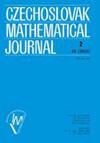费曼路径的不可分性
IF 0.5
4区 数学
Q4 MATHEMATICS
引用次数: 0
摘要
布朗运动粒子轨迹的一个众所周知的数学特性是,这种轨迹在概率为一的情况下是无处不连续、无处不可变的。费曼(R. Feynman,1965 年)和其他学者在没有证明的情况下断言,对于施加了保守力的非相对论量子力学粒子的样本路径(或可能路径),也具有类似的性质。本文利用库兹韦尔和亨斯托克的非绝对积分理论,对费曼的论断进行了介绍性证明。本文章由计算机程序翻译,如有差异,请以英文原文为准。
Non-differentiability of Feynman paths
A well-known mathematical property of the particle paths of Brownian motion is that such paths are, with probability one, everywhere continuous and nowhere differentiable. R. Feynman (1965) and elsewhere asserted without proof that an analogous property holds for the sample paths (or possible paths) of a non-relativistic quantum mechanical particle to which a conservative force is applied. Using the non-absolute integration theory of Kurzweil and Henstock, this article provides an introductory proof of Feynman’s assertion.
求助全文
通过发布文献求助,成功后即可免费获取论文全文。
去求助
来源期刊
CiteScore
0.90
自引率
0.00%
发文量
0
审稿时长
6-12 weeks
期刊介绍:
Czechoslovak Mathematical Journal publishes original research papers of high scientific quality in mathematics.

 求助内容:
求助内容: 应助结果提醒方式:
应助结果提醒方式:


